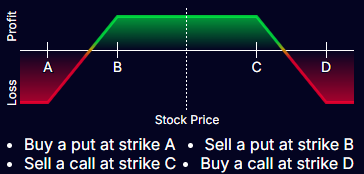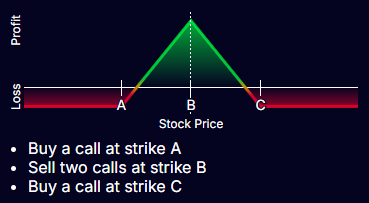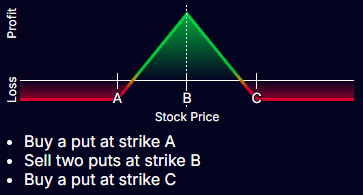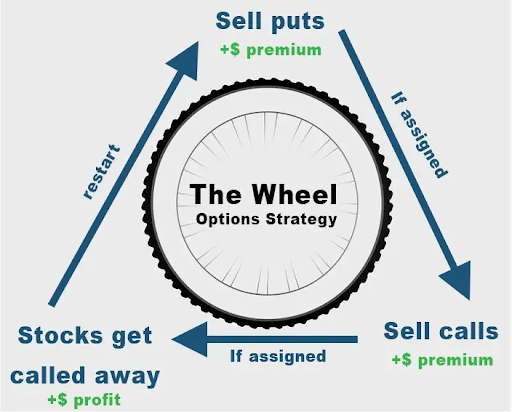Today, we continue learning about wise risk management approaches in trading. In this part, we will talk about neutral strategies that help traders to keep calm and balanced even in volatile markets. Besides, we will introduce you to the Wheel Strategy, a popular, structured approach that helps traders aim for consistent returns while efficiently managing risk.
What Neutral Strategies Are?
Unlike directional strategies (where we bet on a price increase or decrease), neutral approaches profit when the price remains within a range. The goal is to profit from a decrease in volatility (IV) or from time decay (Theta). There are many different neutral strategies. Today, we will look at the simpler ones:
- Iron Butterfly
- Iron Condor
- Long Put Butterfly
- Long Call Butterfly
1. Iron Butterfly
This is a strategy that combines selling a Call and a Put with the same strike, as well as buying protective options outside of that strike. It is suitable if you expect a calm, low-movement market.
Construction:
- Sell 1 ATM Call
- Sell 1 ATM Put
- Buy 1 OTM Call (above the strike)
- Buy 1 OTM Put (below the strike)

Result:
- Maximum profit – when the price at expiration remains close to the middle strike.
- Maximum loss – limited if the price breaks sharply up or down.
Example:
SPY is trading at $500.
- Sell Call with strike 500
- Sell Put with strike 500
- Buy Call with strike 510
- Buy Put with strike 490
Result:
- If SPY stays close to $500 – you collect the premium.
- If it moves outside of $490 or $510 – losses are limited.
2. Iron Condor
Similar to the Iron Butterfly, but the inner strikes do not coincide, meaning the “body” is wider. You profit if the price stays within the range between the sold strikes. Advantage: lower risk than the butterfly because of the wider profit range.
Construction:
- Sell an OTM Call
- Buy an even further OTM
- Sell an OTM Put
- Buy an even further OTM Put

Example:
SPY is trading at $500.
- Sell Call with strike 510
- Buy Call with strike 515
- Sell Put with strike 490
- Buy Put with strike 485
Result:
- Profit if SPY remains between $490 and $510
- Losses – outside of $485 or $515.
3. Long Call Butterfly
The idea behind this is to profit if you expect the price to change slightly, but not too much.
Construction:
- Buy 1 lower Call
- Sell 2 middle Calls
- Buy 1 higher Call

Result:
Small risk, small potential profit. The best result is if the price at expiration is close to the middle strike.
Example:
TSLA is trading at $250
- Buy Call with strike 240
- Sell 2 Calls with strike 250
- Buy Call with strike 260
Result:
If the price ends up close to $250 – maximum profit.
4. Long Put Butterfly
Similarly, but with Put options. Used when you expect a slight drop, but not a crash.
Construction:
- Buy 1 Put with a higher strike
- Sell 2 Puts with a middle strike
- Buy 1 Put with a lower strike

In the case of the above-described neutral strategies, a decrease in volatility will widen the profit zone, and an increase in volatility will narrow the profitable range. Time helps when the position is profitable and hurts when it is not.
5. Wheel Strategy
This is a strategy loved by long-term investors. It is simple, repeatable, and can work for years. Idea: to generate income by owning shares and selling options around them.
How Does It Work?
Step 1: Sell a Put
- Choose a stock you wouldn’t mind owning.
- Sell a Cash-Secured Put (for example, with a strike price below the current market price).
- If the stock price stays above your strike – you simply keep the premium. If the price drops, go to Step 2.
Step 2: You Get Assigned (You Receive the Shares)
If the stock price falls below your strike at expiration, you get assigned, meaning you buy 100 shares (per contract) at the strike price. Now you own the stocks. The next step is to sell a Covered Call against it.
Step 3: Sell a Call
- Sell a Call option with a strike price slightly above your stock’s current price.
- You receive a new premium for that sale.
- If the stock stays below the strike – you keep both the shares and the premium. If the stock rises above the strike – your shares get assigned, and you sell them at the strike price, locking in both your capital gain and the option premium.
Step 4: Start The Cycle Again
Sell a Put → Get Assigned → Sell a Covered Call. That’s why it’s called the Wheel – it just keeps turning.
Example of a Full Wheel cycle
Step 1: Sell a Put
Stock XYZ = $100.
You sell 1 Put contract (1 option contract = 100 shares) with a $95 strike for a $2 premium, expiring in 30 days.
- If the stock stays above $95 until expiration, you keep the full premium of $200 ($2 × 100).
- You can also close the position before expiration (in that case, the premium you keep will be smaller). After collecting your premium, you can sell another Put with a new strike and new premium.
Step 2: If You Get Assigned
If the stock drops to $94 at expiration, you’ll be assigned and end up buying 100 shares at $95.
Step 3: Sell a Call
Now you sell a Call with a $100 strike for a $2 premium.
- If the stock stays below $100 at expiration, you keep your 100 shares and another $200 premium.
- If the stock rises above $100, your shares get called away at $100.
Your total profit in that case:
- $5 per share, (difference between $95 and $100) – total $500 profit
- + $4 total in premiums ($2 from the Put + $2 from the Call) – additional $400 profit
Step 4: Sell Another Put and Start Again
Now you’re back in cash, be ready to sell another Put and start the cycle again.
Remember:
- Put Assignment – you now own the shares. Don’t panic. Just move on to Step 3 and start selling Covered Calls.
- Call Assignment – your shares get sold, but you’ve locked in a profit. You’re back in cash, ready to start the next Wheel cycle.

Final Tips for the Wheel Strategy:
- The Wheel strategy works best with stable, liquid companies (AAPL, NVDA, MSFT, KO, XOM, etc.).
- Always have money in your account to cover the Put (Cash-Secured).
- Don’t chase the maximum premium, choose strikes where you really don’t mind buying the stock.
- If IV is high, it’s a great time to start.




